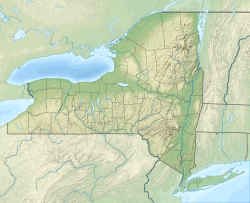Military forts
First fort (Lower Manhattan)
The first Fort George was built in 1626 in the Dutch colony of New Amsterdam and named Fort Amsterdam. The British Army renamed it Fort James in 1664. It was briefly reoccupied by the Dutch from 1673 to 1674 as Fort Willem Hendrick. The British renamed it Fort William Henry in 1691, Fort Anne or Queen's Fort in 1703, and finally Fort George in 1714. The north side bastions and ramparts were destroyed in the American Revolutionary War in 1776 by the Americans and finally demolished in 1790. The site is now the location of the Alexander Hamilton U.S. Custom House in Lower Manhattan.
Second fort (Oswego, NY)
A second Fort George was built by the British in 1755 at Oswego, New York, but it was destroyed by the French commander Louis-Joseph de Montcalm in 1756. The site is now Montcalm Park, bordered by West Schulyer Street, Montcalm Street and West 6th Street. [3]
Fourth fort (Staten Island)
A fourth Fort George was an encampment built on Staten Island around 1777 in the area of St. George, Staten Island, likely Fort Hill. [3] [4] The hill, overlooking the harbor, was the location on Duxbury's Point or Ducksberry Point and was fortified by the British during the American Revolutionary War. [5] Hessian troops, who were contracted by the British, were stationed near the Jersey Street brook (or Hessian Springs). [6]
This page is based on this
Wikipedia article Text is available under the
CC BY-SA 4.0 license; additional terms may apply.
Images, videos and audio are available under their respective licenses.



